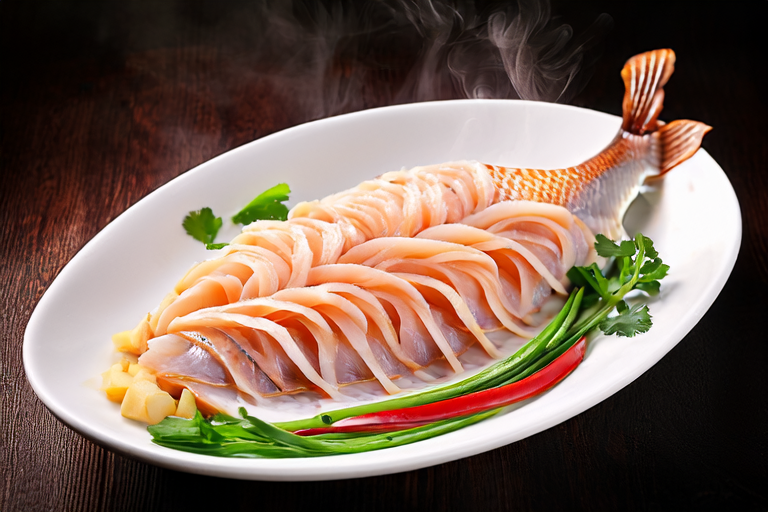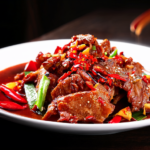- Introduction
In the heart of winter, when the air is crisp and the days grow shorter, there’s nothing more comforting than a steaming hot dish that warms both body and soul. In this article, we’ll explore the art of preparing Jiangsu Style Steamed Mandala Fish, a culinary masterpiece from one of China’s most renowned culinary regions. This dish not only embodies the essence of Jiangsu cuisine but also showcases the delicate balance between simplicity and sophistication.
- The History and Significance of Jiangsu Cuisine
Jiangsu cuisine, also known as Su cuisine, is one of the Eight Great Cuisines of China. It is characterized by its emphasis on fresh ingredients, meticulous preparation, and light yet flavorful dishes. The region’s proximity to rivers and lakes has influenced its cuisine, with freshwater fish and seafood playing a significant role in many traditional recipes. Jiangsu dishes are often steamed or braised, allowing the natural flavors of the ingredients to shine through.
The history of Jiangsu cuisine dates back thousands of years, with roots in the imperial kitchens of Nanjing. Over time, it has evolved into a sophisticated culinary tradition that is both elegant and approachable. Today, Jiangsu-style cooking continues to be celebrated for its refined techniques and attention to detail.
- Selecting the Perfect Fish
Choosing the right fish is crucial for the success of this dish. Mandala fish, also known as pomfret, is a popular choice due to its tender flesh and mild flavor. Look for a fish that is firm to the touch and has clear, bright eyes. Freshness is key, so make sure to purchase your fish from a reputable source.
If you’re unable to find mandala fish, other white-fleshed fish such as sea bass or snapper can be used as alternatives. Ensure that the fish is scaled and gutted, leaving the head and tail intact for presentation purposes. This not only enhances the visual appeal of the dish but also adds depth to its flavor profile.
- Preparing the Fish
Begin by thoroughly cleaning the fish under cold running water. Pat it dry with paper towels and make several shallow cuts along the sides of the fish. These cuts will help the fish cook evenly and absorb the flavors of the marinade.
Next, prepare the marinade. Combine equal parts soy sauce, rice wine, and sugar in a small bowl. Add a pinch of salt and pepper for extra seasoning. Pour this mixture over the fish, making sure to coat it evenly. Let the fish marinate for at least 30 minutes, or up to an hour, to allow the flavors to penetrate deeply into the flesh.
While the fish is marinating, prepare the vegetables. Thinly slice some ginger and green onions. These will be used to garnish the finished dish, adding a refreshing contrast to the rich flavors of the fish.
- Steaming the Fish
To steam the fish, place a heatproof plate or a bamboo steamer lined with parchment paper in a steamer basket. Arrange the fish on top of the plate, ensuring that it is positioned symmetrically for aesthetic purposes. Scatter the sliced ginger and green onions over the fish.
Bring a large pot of water to a rolling boil and carefully lower the steamer basket into the pot. Cover the pot tightly and steam the fish for about 8-10 minutes, depending on the size of the fish. Check for doneness by inserting a sharp knife into the thickest part of the fish; it should flake easily when cooked through.
Once the fish is done, remove the steamer basket from the pot and let it rest for a few minutes before serving. This allows the flavors to meld together and the fish to retain its moisture.
- Serving and Garnishing
Transfer the steamed fish to a serving platter, arranging it attractively. Drizzle any remaining marinade from the plate over the fish for added flavor. Garnish the dish with additional slices of ginger and green onions, as well as a sprinkle of sesame seeds for texture.
Accompany the fish with a side of steamed rice and a simple vegetable stir-fry. The rice will complement the richness of the fish, while the vegetables provide a refreshing crunch. For an authentic Jiangsu dining experience, consider serving the dish with a small bowl of soy sauce mixed with a bit of chili oil and sesame oil for dipping.
- Conclusion
Jiangsu Style Steamed Mandala Fish is a testament to the artistry and precision of Chinese culinary traditions. By mastering the techniques outlined in this recipe, you can bring a touch of elegance and warmth to your winter table. Whether enjoyed on a chilly evening or as part of a larger festive meal, this dish promises to delight both the palate and the senses.
We hope you’ve found this guide informative and inspiring. Happy cooking, and may your kitchen be filled with the aromas of delicious winter fare!


